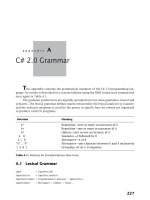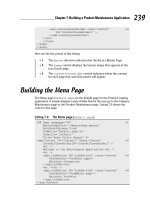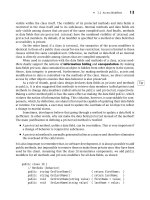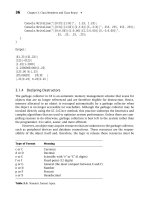Praise for C# 2.0: Practical Guide for Programmers 2005 phần 7 ppt
Bạn đang xem bản rút gọn của tài liệu. Xem và tải ngay bản đầy đủ của tài liệu tại đây (362.46 KB, 24 trang )
138 Chapter 7: Advanced Types, Polymorphism, and Accessors
■
30 Console.WriteLine("Counter starting at: "
31 +counters[c].GetCount());
32 for(intn=0;n<5;n++) {
33 Console.Write(counters[c].GetCount());
34 counters[c].Tick();
35 }
36 Console.WriteLine();
37 }
38 }
39 }
40 }
The methods GetCount, Inc, and Dec are fully implemented and, hence, represent com-
mon behavior for all subclasses that may derive from Counter. The Tick method, on the
other hand, is abstract, requiring subclasses to implement Tick according to their own
needs. The two subclasses, DownCounter and UpCounter, inherit from Counter. When Tick
is implemented by either subclass, it must be preceded by the modifier override as shown
in lines 17 and 22. Hence, implementations are specialized for DownCounter and UpCounter.
In this case, the subclass DownCounter decrements count in its implementation of Tick,
and the subclass UpCounter increments count in its implementation of Tick. If no modi-
fier precedes an inherited method, a warning and an error is generated indicating that the
inherited method in the subclass hides the corresponding method of its parent. But if that
is the intent, then the method Tick must be preceded, instead, by the modifier new.
7.2.3 Using Abstract Classes
In the previous class, TestAbstractCounter, the Main method declares an array of Counter
called counters. The array is initialized to one instance each of DownCounter and UpCounter
(line 27) and, hence, has a length of two. The instance of DownCounter has an initial value
of 9, and the instance of UpCounter has an initial value of 0. For each instance, the method
Tick is invoked five times (lines 32–35). Depending on whether or not it is an instance of
DownCounter or UpCounter, the count is either decremented or incremented as shown by
the following output:
Counter starting at: 0
01234
Counter starting at: 9
98765
7.3 Interfaces
An interface is a special type of abstract class. It provides the signature, but no implemen-
tation of all its members. Therefore, an interface cannot define data fields, constructors,
■
7.3 Interfaces 139
static methods, and constants. Only instance methods, events, properties, and indexers
are permitted, and of course, must be abstract. Like an abstract class, an interface can-
not be instantiated and cannot inherit from multiple abstract classes. However, unlike an
abstract class, any subclass that inherits an interface must implement all members of the
interface. If all interface members are not implemented by the concrete subclass, then
a compilation error is generated. On the other hand, a compilation error is not gener-
ated if an abstract class is not fully implemented by its subclass. For example, a subclass
inheriting from an abstract class may only implement two of four abstract methods. The
other two methods and the subclass itself remain abstract. Hence, abstract classes give
subclasses the freedom to implement or delegate abstract members. Because a subclass
may delegate implementation of an abstract member down the class hierarchy, there is
no guarantee that a subclass is fully implemented. This freedom, though, is not always
useful, especially if the client seeks assurance that a given subclass can be instantiated.
For these reasons, we typically say that a subclass “inherits from” an abstract class but
“implements” an interface.
In C#, a class can inherit from only one base class but can implement any number of
interfaces. This feature is called “single inheritance of classes with multiple inheritance
of interfaces.” Like subclasses, an interface can also tailor a specific behavior by inher-
iting from multiple interfaces. But unlike subclasses, an interface does not, and cannot
by definition, implement the abstract members of its parent interface. That remains the
responsibility of the subclass.
In the .NET Framework, interfaces are often limited to a single method, which reduces
Tip
the likelihood that undesired behavior is inherited. This approach supports the golden
rule of inheritance: Always be completely satisfied with inherited behavior. Dealing with
interfaces that contain only one method also allows one to pick and choose (by inheritance)
those methods that will constitute a new “assembled” behavior. The result is exactly the
right combination of methods, no more and no less. For many years, the design-pattern
community has promoted the adage: Program to an interface, not to an implementation.
7.3.1 Declaring Interfaces
The declarations of an interface and an abstract class are very similar. Other than their
semantic differences concerning inheritance, the interface ICountable given here:
interface ICountable {
bool Tick();
}
is equivalent to the abstract class ACountable:
abstract class ACountable {
public abstract bool Tick();
}
The ICountable interface prescribes common behavior for all subclasses that inherit from
it. Once implemented in a subclass, for example, the method Tick may “bump a count” and
140 Chapter 7: Advanced Types, Polymorphism, and Accessors
■
return true once a maximum or minimum value has been reached. Syntactically, interface
members, such as Tick, are implicitly public and abstract. In fact, no modifier for inter-
face members can be used other than new, which permits an interface member to hide its
inherited member. It is also good programming practice to begin an interface name with a
Tip
capital “I” to distinguish it from a class. The full syntax of an interface declaration is given
here:
EBNF
InterfaceDecl = InterfaceModifiers? "interface" Identifier (":" Interfaces)? "{"
InterfaceMembers
"}" ";"? .
InterfaceModifier = "new" | "public" | "protected" | "internal" | "private" .
InterfaceMember = MethodDecl | PropertyDecl | EventDecl | IndexerDecl .
Now consider two common interface declarations. The ICloneable interface declared here
is used to create copies of an existing object:
public interface ICloneable {
object Clone();
}
Because the return type of Clone is an object reference of the root class, the method Clone
is able to return any instance of any class. Another useful interface is IComparable whose
method CompareTo compares two objects of the same type.
public interface IComparable {
int CompareTo(object o);
}
Once implemented in a subclass, for example, the method CompareTo may return a nega-
tive integer if the current object is “less than” its object parameter, zero if it is equal, and
a positive integer if it is “greater than.” In any case, any class that implements ICountable,
ICloneable,orIComparable must implement their respective methods in some way. The
implementation, however, does not place semantic constraints on the programmer. The
method CompareTo in this case, and the previous methods Tick and Clone, may be imple-
mented in any way as along as the signature of the behavior is satisfied. Common behavior,
therefore, means common use of abstract members. Nonetheless, actual behavior as
defined by implementation should be predictable and disciplined as shown in the following
section.
7.3.2 Implementing Interfaces
As previously pointed out, the members of an interface must be implemented by the class
that inherits it. In the following example, the Counter class inherits part of its behavior
from the interface ICountable, namely the Tick method. Other methods include ToString
that is overridden from the Object class as well as GetCount and SetCount that return and
initialize count, respectively.
■
7.3 Interfaces 141
class Counter : ICountable {
public Counter(int c) { count = c; }
public Counter() : this(0) { }
public override string ToString() { return ""+count; }
// same as count.ToString()
public int GetCount() { return count; }
protected void SetCount(int c) { count = c; }
public bool Tick() { return ++count == System.Int32.MaxValue; }
private int count;
}
The implementation of Tick increments count by one and returns true once the maximum
integer value Int32.MaxValue is reached.
If it is recognized that all counters, in addition to those defined by Counter, exhibit
a common behavior described by GetCount, then that behavior is best encapsulated and
explicitly defined as an interface:
public interface IRetrievable {
int GetCount();
}
Furthermore, to make copies of Counter objects, the Counter class may also implement
ICloneable. The final changes to the class Counter are highlighted here:
class Counter : ICountable, IRetrievable, ICloneable {
public object Clone() { return this.MemberwiseClone(); }
}
The class Counter now inherits and implements three interfaces, and each one includes
only a single method. Because the signature of the GetCount method in Counter is the same
as the corresponding method in IRetrievable, its definition is unaffected. The description
for MemberwiseClone is found in Chapter 4; it is implicitly inherited from the root class
Object.
7.3.3 Using Interface Methods
Because an interface is typically small and defines a limited behavior, several classes are
likely to implement the same interface. Therefore, instances of classes like the following,
Counter and BoundedCounter, share a common behavior:
public class Counter : ICloneable, IRetrievable { }
public class BoundedCounter : IRetrievable { }
142 Chapter 7: Advanced Types, Polymorphism, and Accessors
■
Both classes inherit from the interface IRetrievable and therefore implement its GetCount
method. However, only Counter inherits behavior from ICloneable and has access to the
Clone method.
If a reference is guaranteed to contain an object of an interface type, then it can
be safely cast and seen as an object of that type. In the following example, the method
InvokeService retrieves and outputs the count of each object in the counters array. The
array parameter, however, may contain instances of both Counter and BoundedCounter,
both of which have implemented the IRetrievable interface.
void InvokeService(IRetrievable[] counters) {
for(intn=0;n<counters.Length; n++)
System.Console.WriteLine("Counter #{0}: {1}", n,
counters[n].GetCount() );
}
Since instances of both Counter and BoundedCounter contain GetCount, they can safely
invoke it through instances of IRetrievable without explicit casting. However, if an
object does not have access to the method of an interface, in this case GetCount, then an
InvalidCastException is raised and the program terminates. Casting therefore runs a risk.
Suppose now that the array counters is of type IRetrievable and, hence, is able to
contain a mix of instances from Counter and BoundedCounter. Suppose also that only those
instances of Counter are to be cloned and returned in a list. Since the Counter class inherits
additional behavior called Clone from the ICloneable interface and since this behavior is
not available from either the Object class or the IRetrievable interface, explicit casting
is insufficient and raises an exception if objects of type BoundedCounter are cloned. In this
case, it is far safer to test for compatibility using the is operator, shown here:
ArrayList InvokeService(IRetrievable[] counters) {
ArrayList list = new ArrayList();
for(intn=0;n<counters.Length; n++) {
System.Console.WriteLine("Counter #{0}: {1}", n,
counters[n].GetCount() );
if (counters[n] is ICloneable)
list.Add( ((ICloneable)counters[n]).Clone() );
}
return list;
}
In the previous example, there is no reference to any concrete class type, such as Counter
and BoundedCounter. There is simply no need to know which objects of what class make
up the array counters. Hence, it is easy to add new concrete classes that derive from these
interfaces without changing the code of InvokeService.
Delegates and interfaces are two important features of the C# language that can iso-
late a single method from large classes with many public services. An interface, on one
■
7.4 Polymorphism and Virtual Methods 143
hand, offers only a few public services (typically one) that must be implemented as a
contract by the subclass that derives from it. A delegate, however, offers a single public
service
1
that is not necessarily related to a particular object or interface. From a caller’s
point of view, it is only necessary to match the signature of a method with that of the
delegate.
7.4 Polymorphism and Virtual Methods
Unlike inheritance, which is a compile-time mechanism, polymorphism is the runtime
ability of a reference to vary its behavior depending on the type of object that is currently
assigned to it. This dynamic routing (or binding) of messages to methods is one of the three
hallmarks of object-oriented programming in addition to classes and inheritance. Although
making decisions (tests, branching, and so on) at compile-time is very efficient, any change
may require considerable recompilation. On the other hand, with polymorphism, decisions
can be changed at runtime and routed to the correct behavior.
Dynamic binding does come with some computational overhead. However, faster
processors, larger memories, and better compilers have reduced this cost considerably.
Nonetheless, tools such as profilers are very helpful in pinpointing those sections of code
that can afford the luxury of polymorphism. In any case, it is always worthwhile to investi-
gate the possibility since polymorphism leads to software that is more flexible, extendable,
and easier to maintain in the long run.
When a class is designed, it is advantageous to make methods polymorphic or
Tip
virtual. Therefore, if a method is inherited and does not satisfy the specific requirements
of the derived class, it can be redefined and reimplemented. Such a method is said to be
overridden. In Chapter 4, methods for the BoundedCounter class were inherited “as is”
from their base class Counter. In this section, we examine how methods are overridden
using the modifier override to redefine the behavior of virtual (polymorphic) methods.
Using a suite of counters, we also show how dynamic binding takes place for polymorphic
objects.
7.4.1 Using the Modifiers override and virtual
If an inherited method is to be completely redefined, the corresponding method of the
base class must be preceded by the modifier virtual as shown here:
class Counter {
public virtual bool Tick() { }
}
1
It could be argued that more than one public service is offered using a combination of delegates but
the restrictions are quite severe.
144 Chapter 7: Advanced Types, Polymorphism, and Accessors
■
To demonstrate the process of redefining Tick, the class BoundedCounter is reintroduced.
A bounded counter is a counter that begins with an initial value and then counts up or
down within a range delimited by minimum and maximum values. If the count exceeds the
maximum value when counting up, then it is reset to the minimum value. If the count falls
below the minimum value when counting down, then it is reset to the maximum value. The
default bounded counter starts at 0, has 0 and Int32.MaxValue for its min and max values
respectively, and has an directionUp of true. The default increment is 1 unless otherwise
established by the method SetIncrement. The full implementation of the BoundedCounter
is shown here:
class BoundedCounter : Counter {
public BoundedCounter(int count, int min, int max,
bool directionUp) : base (count) {
this.min = min;
this.max = max;
this.directionUp = directionUp;
this.increment = 1;
}
public BoundedCounter() : this(0, 0, Int32.MaxValue, true) { }
public override string ToString() {
return GetCount()+"["+GetMin()+" "+GetMax()+"] "
+(directionUp?"UP":"DOWN");
}
// Bumps the count depending of counter’s direction and increment.
public override bool Tick() {
if (directionUp) {
if (GetCount() + GetIncrement() > GetMax()) {
SetCount(min);
return true;
} else {
SetCount(GetCount() + GetIncrement());
}
} else {
if (GetCount() - GetIncrement() < GetMin()) {
SetCount(max);
return true;
} else {
SetCount(GetCount() - GetIncrement());
}
}
return false;
}
■
7.4 Polymorphism and Virtual Methods 145
// Gets the minimum count value.
public virtual int GetMin() { return min; }
// Gets the maximum count value.
public virtual int GetMax() { return max; }
// Gets the count’s increment.
public virtual int GetIncrement() { return increment; }
// Sets the count’s increment.
public virtual void SetIncrement(int n) { increment = n; }
// Gets the count’s direction.
public virtual bool getDirection() { return directionUp; }
// Sets the count’s direction.
public virtual void setDirection(bool value) {
if (value != directionUp) directionUp = value;
}
private int increment;
private int min, max;
private bool directionUp;
}
The class BoundedCounter inherits from the class Counter. Since Tick is virtual in Counter,
it is redefined in BoundedCounter by preceding its implementation of Tick with the modifier
override. Overriding a polymorphic method only happens when the name and parameter
list of both the parent and derived class are the same. Also note that BoundedCounter
introduces several virtual methods (such as GetMin, GetMax, GetIncrement, and so on),
which can also be redefined by any class that derives from BoundedCounter.
7.4.2 Adding and Removing Polymorphism
When deciding whether or not to add or remove polymorphism, it is best to look “under
the hood” and see how static, instance, and virtual methods are invoked. For optimiza-
tion purposes, a call to a static (class) method is equivalent to a call in a procedural
language. Without dynamic binding, the invocation directly calls the function code entry
point. Instance methods are invoked through a this pointer that is implicitly passed as
the first parameter and generated automatically by the compiler. Finally, virtual methods
are invoked via the runtime system, which interprets a (virtual) object reference. This ref-
erence contains two parts: the type of the object invoking the method, and the offset of
that method in a method table (also known as a virtual table). The method table is an array
of pointers to functions that enables an invocation to be indirectly and dynamically routed
to the correct function code entry point.
146 Chapter 7: Advanced Types, Polymorphism, and Accessors
■
Clearly, polymorphism comes with a computational overhead. Adding polymorphism
via virtual methods involves weighing flexibility against performance. Although database
and network accesses tend to be the bottlenecks of today’s applications, the use of profilers
can still pinpoint where and when optimization is really required.
In the following example, class D inherits from class B and redefines the method
signatures of IM, SM, and VM using the new keyword. For the method VM, the polymorphic
chain is broken. For methods IM and SM, on the other hand, a new polymorphic chain is
started.
class B {
public void IM() {} // Instance method.
public static void SM() {} // Static method.
public virtual void VM() {} // Virtual method.
}
classD:B{
new public virtual void IM() {} // Redefine instance as virtual method.
new public virtual void SM() {} // Redefine static as virtual method.
new public static void VM() {} // Redefine virtual as static method.
}
Further explanation of the new modifier is provided in Section 7.8.
7.4.3 Using Dynamic Binding
Now that the BoundedCounter class is available, four additional counters are presented,
including the two subclasses UpCounter and DownCounter, given here:
class DownCounter : BoundedCounter {
public DownCounter(int count) : base(count, 0, 9, false) { }
}
class UpCounter : BoundedCounter {
public UpCounter(int count) : base(count, 0, 59, true) { }
}
These subclasses inherit from BoundedCounter and reuse its constructor with the base key-
word. As the names imply, UpCounter increases its count at every Tick, and DownCounter
decreases its count at every Tick.
The next refinement is the definition of a cascaded counter. A cascaded counter
is a counter that, when it reaches its maximum value, increments a second counter (if
attached). In the following CascadedCounter class, this second counter is passed as a
parameter and assigned to the private data member upper of type ICountable.Ifno
counter is attached, then null is passed and assigned to upper. Again, the Tick method of
CascadedCounter is overridden to implement the dependence of one counter on the other.
■
7.4 Polymorphism and Virtual Methods 147
Once count, which is inherited from the class Counter, reaches its maximum value, two
things occur: count is reset to its minimum value and upper is incremented by one.
class CascadedCounter : BoundedCounter {
public CascadedCounter(int max, ICountable upper) :
base(0, 0, max, true) {
this.upper = upper;
}
public override bool Tick() {
bool overflow = false;
if ( base.Tick() ) {
SetCount(GetMin());
if (upper != null) upper.Tick();
overflow = true;
}
return overflow;
}
private ICountable upper;
}
Like UpCounter and DownCounter, CascadedCounter is derived from BoundedCounter and
invokes the constructor of its parent class using the keyword base.
Finally, an HourMinute class is defined to simulate a simple watch display formatted
as hh:mm. In the constructor of this class, which is defined next, two objects of the class
CascadedCounter are instantiated and assigned to data members hour and minute of type
Counter. Note that Counter type is compatible with any derived objects, such as those
from CascadedCounter.
class HourMinute : ICountable {
public HourMinute() {
hour = new CascadedCounter(59, null);
minute = new CascadedCounter(59, hour);
}
public bool Tick() { return minute.Tick(); }
public override string ToString() {
return String.Format("{0:D2}:{1:D2}", hour.GetCount(),
minute.GetCount());
}
private Counter hour;
private Counter minute;
}
The hour object, as expected, represents the hour part of the display. It is instantiated with
a null reference as a second parameter since there is no link to any upper counter. The
148 Chapter 7: Advanced Types, Polymorphism, and Accessors
■
minute object is instantiated and receives as its second parameter the hour reference as its
upper counter. This is used to trigger an overflow when the maximum number of minutes is
reached. Like BoundedCounter, the Tick method of HourMinute is also overridden. Although
the minute object is defined as type Counter, its behavior is dynamically routed to the
Tick method of CascadedCounter since an object of the latter class is assigned to minute in
the constructor method. Hence, when the count of minute reaches 60, the Tick method of
CascadedCounter resets the count of minute to 0 and increments the count of hour by one.
To further demonstrate polymorphic behavior and to test all counters previously
mentioned, a test program called TestInterface is shown here:
public class TestInterface {
public static void Main() {
Counter up = new BoundedCounter(0, 0, 5, true);
System.Console.WriteLine("UpCounter [0 5] starting at 0: ");
for(intn=0;n<14;n++) {
System.Console.Write("{0} ", up.GetCount());
up.Tick();
}
Counter down = new BoundedCounter(5, 0, 5, false);
System.Console.WriteLine("\n\nDownCounter [5 0] starting at 5: ");
for(intn=0;n<14;n++) {
System.Console.Write("{0} ", down.GetCount());
down.Tick();
}
Counter ch = new UpCounter(5);
System.Console.WriteLine("\n\nUpCounter [0 59] starting at 5: ");
for(intn=0;n<61;n++) {
System.Console.Write("{0} ", ch.GetCount());
ch.Tick();
}
Counter cd = new DownCounter(5);
System.Console.WriteLine("\n\nDownCounter [9 0] starting at 5: ");
for(intn=0;n<14;n++) {
System.Console.Write("{0} ", cd.GetCount());
cd.Tick();
}
Counter ch2 = new UpCounter(5);
System.Console.WriteLine("\n\nUpCounter [0 59] starting at 5 by 2: ");
((BoundedCounter)ch2).SetIncrement(2);
■
7.4 Polymorphism and Virtual Methods 149
for(intn=0;n<61;n++) {
System.Console.Write("{0} ", ch2.GetCount());
ch2.Tick();
}
Counter cd2 = new DownCounter(5);
System.Console.WriteLine("\n\nDownCounter [9 0] starting at 5 by 2: ");
((BoundedCounter)cd2).SetIncrement(2);
for(intn=0;n<14;n++) {
System.Console.Write("{0} ", cd2.GetCount());
cd2.Tick();
}
System.Console.WriteLine("\n\nHourMinute:");
HourMinute hhmm = new HourMinute();
for(intn=0;n<64;n++) {
System.Console.Write("{0} ", hhmm.ToString());
hhmm.Tick();
}
}
Variables of type Counter are assigned instances of BoundedCounter, UpCounter, and
DownCounter. In all cases, the appropriate Tick method is invoked depending on what
type of object is currently assigned to the variable. For example, when variable cd2 of
type Counter is assigned an instance of DownCounter then the inherited Tick method of
DownCounter would be invoked. Since the Tick method of DownCounter did not redefine the
Tick method of BoundedCounter, the behavior of the two is equivalent. Notice the explicit
cast that must be applied to the Counter objects, ch2 and cd2, in order to invoke the
SetIncrement method of the BoundedCounter class. The sample output of the test program
follows:
UpCounter [0 5] starting at 0:
01234501234501
DownCounter [5 0] starting at 5:
54321054321054
UpCounter [0 59] starting at 5:
5678910111213141516171819202122232425262728293031
32 33 34 35 36 37 38 39 40 41 42 43 44 45 46 47 48 49 50 51 52 53 54 55 56
575859012345
DownCounter [9 0] starting at 5:
54321098765432
150 Chapter 7: Advanced Types, Polymorphism, and Accessors
■
UpCounter [0 59] starting at 5 by 2:
5791113151719212325272931333537394143454749515355
5759024681012141618202224262830323436384042444648
5052545658024
DownCounter [9 0] starting at 5 by 2:
53197531975319
HourMinute:
00:00 00:01 00:02 00:03 00:04 00:05 00:06 00:07 00:08 00:09 00:10 00:11 00:12
00:13 00:14 00:15 00:16 00:17 00:18 00:19 00:20 00:21 00:22 00:23 00:24 00:25
00:26 00:27 00:28 00:29 00:30 00:31 00:32 00:33 00:34 00:35 00:36 00:37 00:38
00:39 00:40 00:41 00:42 00:43 00:44 00:45 00:46 00:47 00:48 00:49 00:50 00:51
00:52 00:53 00:54 00:55 00:56 00:57 00:58 00:59 01:00 01:01 01:02 01:03
7.5 Properties
A property is an accessor that provides and encapsulates access to a data field. In the past,
object-oriented languages such as Smalltalk, C++, and Java have simply used conventions
to access the data fields of objects and classes. These conventions have centered on the
implementation of getter and setter methods to retrieve and update information. In C#,
properties are incorporated as field extensions with a syntax that appears to access the data
fields directly. Even if properties give this impression, they are nonetheless implemented
as methods as described in the following subsections.
7.5.1 Declaring get and set Accessors
In Java, access to a data field is typically implemented with two methods. The two methods,
prefixed with get and set, respectively, retrieve and assign values from a data field as
follows:
class Id {
public String getName() { return name; }
public void setName(String value) { name = value; }
private String name;
}
Using a more intuitive syntax, properties in C# encapsulate two accessor methods called
get and set within the same block of code as shown here:
class Id {
public string Name { // Declaration of the Name property.
get { return name; }
■
7.5 Properties 151
set { name = value; }
}
private string name; // Declaration of the name field.
}
Every set method has exactly one implicit parameter called value with the same type as the
field with which the property is associated. Because set accessors have write-only prop-
erties, they also have a tendency to throw exceptions when receiving invalid parameters.
Therefore, validation may be required before assigning the value parameter to a field mem-
ber. A get accessor, on the other hand, should not change a data field but merely return
its value. It is therefore good practice to avoid throwing exceptions from get accessors
Tip
since they are primarily used as read-only access to objects.
To illustrate the invocation of both the get and set accessors, consider the following
example:
Id id = new Id();
id.Name = "Michel";
id.Name = id.Name+"deChamplain";
In this example, an object id is created and its field name is first set to "Michel" through the
property Name. On the following line, the get accessor is invoked to retrieve the field name
before it is concatenated with " de Champlain". The field name is then set to the resultant
string.
Both get and set accessors specify read and write properties that should always
return and receive a copy of an object’s private data (value or reference type). Although this
seems safe enough for value types, care must be exercised for reference types. Returning
or receiving a reference to the private data of an object results in sharing what is supposed
to be protected and well encapsulated.
7.5.2 Declaring Virtual and Abstract Properties
A property, unlike a field, can be overridden. Therefore, it is good programming practice Tip
to declare virtual or abstract properties, especially when behavior needs to be redefined.
For example, the Counter class (lines 1–13 of the next example) supports counters within a
byte range from 0 to MaxValue (255). Its Max property is used only in the ToString method
(line 10). The set accessor (line 6) associated with the count field does not use the Max
property for validation. On the other hand, if a BoundedCounter class (lines 15–28) wishes
to restrict its range to a specific maximum value at creation time (line 16), then it is impor-
tant to override the get accessor (line 19) of the Max property and the set accessor (lines
22–25) of the Count property. With this extension, the class Counter does not need to be
modified since its ToString method is routed dynamically to the Max property based on
the instance of its caller’s type.
1 class Counter {
2 public virtual byte Max {
152 Chapter 7: Advanced Types, Polymorphism, and Accessors
■
3 get { return System.Byte.MaxValue; }
4}
5 public virtual byte Count {
6 set { count = value; }
7 get { return count; }
8}
9 public override string ToString() {
10 return ""+Count+"[0 "+Max+"]";
11 }
12 private byte count;
13 }
14
15 class BoundedCounter : Counter {
16 public BoundedCounter(byte max) { this.max = max; }
17
18 public override byte Max {
19 get { return max; }
20 }
21 public override byte Count {
22 set {
23 if (value > Max) base.Count = Max;
24 else base.Count = value;
25 }
26 }
27 private byte max;
28 }
29
30 class TestCounter {
31 public static void Main(string[] args) {
32 Counter c = new Counter();
33 System.Console.WriteLine(c.ToString());
34 c.Count = 4;
35 System.Console.WriteLine(c.ToString());
36
37 c = new BoundedCounter(5);
38 System.Console.WriteLine(c.ToString());
39 c.Count = 6;
40 System.Console.WriteLine(c.ToString());
41 }
42 }
Output:
0[0 255]
4[0 255]
■
7.5 Properties 153
0[0 5]
5[0 5]
Properties support read-only, write-only, or both read/write access to fields. However,
overridden properties are only possible for the accessors that are declared. In other words,
a write-only property (using a set) cannot be extended to a read/write property.
As shown next, the use of an interface (lines 1–3) and an abstract class (lines 5–11) is
sometimes ideal for specifying the desired accessors of virtual properties. The following
example illustrates this combination for the declaration of our previous Counter class:
1 interface ICounter {
2 byte Count { set; get; }
3}
4
5 abstract class Counter : ICounter {
6 public virtual byte Count { // Default implementation.
7 set { count = value; }
8 get { return count; }
9}
10 private byte count;
11 }
12
13 class Counter2 : Counter {
14 public virtual byte Max {
15 get { return System.Byte.MaxValue; }
16 }
17 public override string ToString() {
18 return ""+Count+"[0 "+Max+"]";
19 }
20 }
The Counter abstract class implements a default behavior for the Count property, and the
Counter2 concrete class implements the Max property and ToString method. Note that the
interface ICounter, like all interfaces, does not specify an access modifier for its members.
They are always implicitly public. Therefore, the property Count in ICounter has public
access.
7.5.3 Declaring Static Properties
A static (or class) property behaves like static data and is accessed via its class name. The
following Id class increments a static counter number corresponding to the number of Id
objects created.
1 public class Id {
2 public Id() { ++number; }
154 Chapter 7: Advanced Types, Polymorphism, and Accessors
■
3 static Id() { number = 0; }
4 public static int Number { get { return number; } }
5 private static int number;
6}
7
8 public class TestCounter {
9 public static void Main(string[] args) {
10 new Id();
11 System.Console.WriteLine(Id.Number);
12 new Id();
13 System.Console.WriteLine(Id.Number);
14 }
15 }
Output:
1
2
Static properties cannot be referenced through an instance variable and, hence, the
following access will generate a compilation error:
new Id().Number
7.5.4 Declaring Properties with Accessor Modifiers
A typical component is designed with public accessibility for both get and set accessors.
But applications may also need accessors with different accessibilities. For example, a
public get accessor may need to be combined with a protected or internal set acces-
sor that restricts access to derived classes or classes within the same assembly. In order
C# 2.0
to achieve this flexibility, accessors too may have access modifiers. These modifiers,
however, are not applicable to accessors within an interface.
If a property has no override modifier then an accessor modifier is allowed only if
both get and set accessors are defined. In addition, only one of the two accessors may
have a modifier other than public as shown here:
public class Counter {
public virtual byte Count {
protected set { count = value; } // Accessible to derived classes.
get { return count; } // Accessible to all clients.
}
private byte count;
}
If an accessor needs to be overridden in the case of a virtual property then the accessors of
the override property must match the signatures of the accessors in the virtual property.
■
7.6 Indexers 155
For example, if Counter2 inherits from Counter then the virtual property of Counter is
overridden as follows:
public class Counter2 : Counter {
public override byte Count {
protected set { }
get { }
}
}
As a final note, the accessibility of an accessor must be at least as restrictive as that of its
encapsulating property, as summarized in Table 7.1.
The complete EBNF definition for a property declaration is given here:
EBNF
PropertyDecl = Attributes? PropertyModifiers? Type MemberName
"{" AccessorDecls "}" .
PropertyModifier = "new" | "public" | "protected" | "internal" | "private"
| "static" | "virtual" | "sealed" | "override"
| "abstract" | "extern" .
AccessorDecls = ( GetAccessorDecl SetAccessorDecl? )
| ( SetAccessorDecl GetAccessorDecl? ) .
GetAccessorDecl = Attributes? AccessorModifier? "get" AccessorBody .
SetAccessorDecl = Attributes? AccessorModifier? "set" AccessorBody .
AccessorModifier = "protected | "internal" | "private"
| ("protected" "internal") | ("internal" "protected") .
AccessorBody = Block | ";" .
Property Modifier Applicable Accessor Modifiers
public Any
protected internal internal, protected,orprivate
internal or protected private
private None
Table 7.1: Restrictive accessibility for accessors.
7.6 Indexers
An indexer is an accessor that enables an object to be treated in the same way as an array,
where any number and type of parameters can be used as indices. Therefore, defining
an indexer in C# is equivalent to redefining the operator []. An indexer is considered
when a class is better represented as a virtual container of data that can be retrieved or
set using indices. Since an indexer is nameless, its signature is specified by the keyword
156 Chapter 7: Advanced Types, Polymorphism, and Accessors
■
this followed by its indexing parameters within square brackets. Like methods, indexers
can also be overloaded. The following example of an indexer illustrates its use to access
an int as an array of bits:
1 using System;
2 using System.Text;
3
4 namespace BitIndexer {
5 public class IntBits {
6 public bool this [int index] {
7 get {
8 if (index<0||index >= BitsPerInt)
9 throw new ArgumentOutOfRangeException();
10
11 return (bits & (1 << index)) != 0;
12 }
13 set {
14 if (index<0||index >= BitsPerInt)
15 throw new ArgumentOutOfRangeException();
16
17 if (value)
18 bits |= (1 << index);
19 else
20 bits &= ˜(1 << index);
21 }
22 }
23 public override string ToString() {
24 StringBuilder s = new StringBuilder("[ ");
25 for(intn=0;n<BitsPerInt; n++)
26 s.Append(this[n] ? "1 ": "0 ");
27 s.Append("]");
28 return s.ToString();
29 }
30 private int bits;
31 private const int BitsPerInt = 32;
32 }
33
34 public class TestBitIndexer {
35 public static void Main() {
36 IntBits ibits = new IntBits();
37
38 ibits[6] = true; // set
39 bool peek = ibits[2]; // get
40 ibits[6] = ibits[2] || peek; // get and set
■
7.7 Nested Types 157
41
42 Console.WriteLine( ibits.ToString() );
43 }
44 }
45 }
An int in C# has 32 bits (line 31). Therefore, validation must be made upon entry to the get
(lines 8–9) and set (lines 14–15) accessors to ensure that the index is within the integer bit
range 0 31. Otherwise, a ArgumentOutOfRangeException is thrown. Access to an object of
IntBits is shown on lines 38–40. Notice that internal use of the get accessor is also made
within the ToString method on line 26 in order to peek at an indexed value and to use its
corresponding boolean value to append the string "1 " or "0 ".
In terms of modifiers, there are three key differences between an indexer and a
property. First, a property is identified by its name whereas an indexer is identified by
its signature. Second, a property can be a static member, but an indexer is always an
instance member. Third, an indexer must have at least one parameter. In a similar vein,
however, the restrictions on accessor modifiers for properties also apply to indexers. The
complete EBNF definition for an indexer declaration is given here:
EBNF
IndexerDecl = Attributes? IndexerModifiers? IndexerDecltor
"{" AccessorDecls "}" .
IndexerModifier = "new" | "public" | "protected" | "internal" | "private"
| "static" | "virtual" | "sealed" | "override"
| "abstract" | "extern" .
IndexerDecltor = Type ( InterfaceType "." )? "this"
"[" FormalParameterList "]" .
7.7 Nested Types
Types can be nested in order to localize and use abstractions within one type only. For
example, a class can have nested declarations of classes, structures, interfaces, enu-
merations, and delegates, where each nested declaration has either public, protected,
internal, protected internal,orprivate access. If the access is not specified, private
is the default. Such localization may also be achieved by defining internal types within the
same namespace and compiled separately.
The following example presents a class A in a namespace NT that uses nested types.
This class processes internal work by creating and invoking instances of nested types.
Although an instance of class A can be created outside NT, there is no access to any of its
nested types:
namespace NT { // Using Nested Types
public class A {
public A() { DoInternalWork(); }
158 Chapter 7: Advanced Types, Polymorphism, and Accessors
■
// Internal methods:
static void CallBack() {}
void DoInternalWork() {
new S().M();
new C().M();
new M(A.CallBack)();
}
// Internal nested types:
internal interface I { void M(); }
internal class C:I{public void M() {} }
internal structS:I{public void M() {} }
internal delegate void M();
}
}
The next example presents an equivalent class A in a namespace IT that uses internal types
instead. This class processes the same internal work by creating and invoking instances of
its internal types. Again, although an instance of class A can be created outside IT, there
is no access to any of its internal types:
namespace IT { // Using Internal Types
public class A {
public A() { DoInternalWork(); }
// Internal methods:
static void CallBack() {}
void DoInternalWork() {
new S().M();
new C().M();
new M(A.CallBack)();
}
}
// Internal types:
interface I { void M(); }
class C:I{public void M() {} }
structS:I{public void M() {} }
delegate void M();
}
Consider the following main application (compiled separately), which attempts to use all
the previous types. As expected, each attempted access to the internal and nested types
generates the same compilation error stating that such type is inaccessible due to its
■
7.8 Other Modifiers 159
protection level:
namespace TestNestedAndInternalTypes {
using NT;
using IT;
public class MainTest {
public static void Main() {
new NT.A();
new NT.A.S().M(); // Error: inaccessible.
new NT.A.C().M(); // Error: inaccessible.
new NT.A.M(NT.A.CallBack)(); // Error: inaccessible.
new IT.A();
new IT.S().M(); // Error: inaccessible.
new IT.C().M(); // Error: inaccessible.
new IT.M(IT.A.CallBack)(); // Error: inaccessible.
}
}
}
7.8 Other Modifiers
Other modifiers for type members include sealed, volatile, and extern. The sealed modi-
fier means that a class cannot be extended or subclassed. System.String is an example of a
sealed class that precludes any unwanted extensions. It can also used on virtual methods
and properties to prevent further derived classes from overriding them. The volatile
modifier denotes a member that can be modified asynchronously (hardware or thread) as
in C/C++. The extern modifier specifies a method implemented in some other language,
usually C or C++.
The new modifier, which was briefly introduced in Section 7.4.2, is used to break a
polymorphic chain. If new is combined with the virtual modifier on the same member then
a new polymorphic chain is started. Combining new with the override modifier, however,
generates a compilation error.
In the following example, an existing Counter class has (unfortunately) not declared
its GetCount method as virtual. In order to make it virtual without editing the existing file
where the class is implemented, the GetCount method is inherited by a new class called
NewCounter and redeclared as virtual with the help of the new modifier. Although the
constructor of NewCounter also initializes a max bound, there is no need to use new with
the method Tick. We need only override Tick to check with max instead of the predefined
constant Int32.MaxValue:
public interface ICountable {
bool Tick();
}
160 Chapter 7: Advanced Types, Polymorphism, and Accessors
■
public class Counter : ICountable {
public Counter () { count = 0; }
public int GetCount() { return count; }
public override string ToString() { return count.ToString(); }
protected void SetCount(int newCount) { count = newCount;}
public virtual bool Tick() { return ++count == Int32.MaxValue; }
private int count;
}
public class NewCounter : Counter {
public NewCounter(int max) : base() { this.max = max; }
public new virtual int GetCount() { return base.GetCount(); }
public override bool Tick() {
SetCount(base.GetCount()+1);
if (base.GetCount() == GetMax()) {
SetCount(0);
return true;
}
return false;
}
public int GetMax() { return max; }
private int max;
}
public class TestNewModifier {
public static void Main() {
ICountable c = new Counter();
NewCounter c2 = new NewCounter(3);
for(intn=0;n<9;n++) {
System.Console.Write( c.ToString() ); c.Tick();
}
System.Console.WriteLine();
for(intn=0;n<9;n++) {
System.Console.Write( c2.ToString() ); c2.Tick();
}
System.Console.WriteLine();
}
}
Output:
012345678
012012012
■
7.8 Other Modifiers 161
As a final note, the new modifier is also helpful in controlling changes to a third-party class
library used in current projects or applications. Consider the following method M declared
in class A within the ThirdPartyLib class library namespace. Suppose also that class B
inherits from class A and uses method M in the current OurLib namespace.
namespace ThirdPartyLib {
public class A {
public void M() { }
}
}
namespace OurLib {
public classB:A{
public void My() {
M();
}
}
}
If the manufacturer, say, releases a new version of the ThirdPartyLib class library and
changes the name of method M to My, this change in their public interface forces the recom-
pilation of our class B. The recompilation generates a warning message because class B.My
now hides the inherited member A.My. This warning can be removed by adding the new
keyword in front of the method B.My and by using the base prefix to call A.My as shown
here:
namespace ThirdPartyLib {
public class A {
public void My() { } // Change to the public interface of the
// library class.
}
}
namespace OurLib {
public classB:A{
public new void My() { // Warning is removed.
base.My(); // Access to the inherited method is still
// possible.
}
}
}









